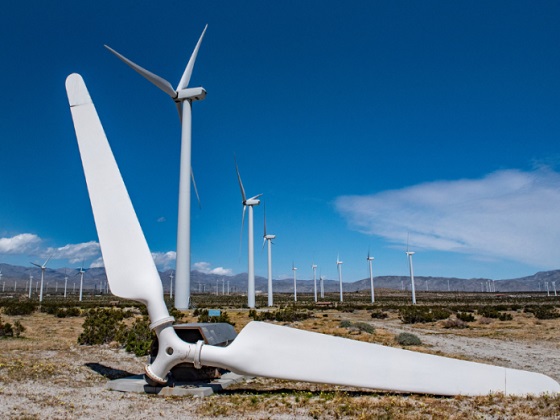Energy
Buckle Up for Summer Blackouts: Wind Is Already Failing Texas in Spring

From Heartland Daily News
By Jason Isaac
When the wind blows too much, natural gas plants are forced to shut down because they can’t underbid wind producers that can bid zero or negative. But when the wind doesn’t blow when it is needed, wind generators can afford the loss of revenue because they earn so much from tax subsidies.
It’s been all quiet on the electric grid front for a few months — but don’t get your hopes up. Over the last month, electricity prices came near the $5000/MWh regulatory cap three separate times because the wind wasn’t blowing enough when the sun went down.
If this sounds familiar, you’re not wrong.
You may hear from the drive-by media that the problem is unseasonably warm temperatures, or that there are a lot of power plants down for maintenance. But high 80s in April and low 90s in May are not unusual, and the Texas grid used to manage these weather changes with no problems. From 2014 to 2016, real-time prices only went over $1000/MWh twice, but it’s happened three times already this year.
If the grid is already on shaky ground, with many weeks to go before blistering triple-digit temperatures shoot electric demand through the roof, all signs are pointing to an unpleasant summer.
The problem with the Texas grid is so simple it’s infuriating: Relying too heavily on unpredictable wind and solar, without enough reliable reserve capacity, means higher volatility — leading to higher prices and increasing need for expensive interventions by ERCOT to avoid outages. This is why your electric bill is going up and up even though wind and solar are supposed to be cheap.
While Texas certainly has a lot of sun, peak solar output almost never aligns with peak electric usage. The Lone Star State also has plenty of wind, but wind generation is wildly unpredictable — by nature. It’s not unusual for a wind generator’s output to swing 60 percentage points or more in a single week.
Take last month, for example. On Tuesday, April 16, electricity prices reached their cap because ERCOT’s day-ahead wind forecast was off by 50%. Five gigawatts of wind we were counting on to power Texas as the sun went down didn’t show up. That was the equivalent of simultaneously shutting down 10 large natural gas units, or all of the state’s nuclear capacity. If the latter occurred, the news media would be up in arms (and rightfully so). But because the culprit was the political darling of both the left and the right, no one heard about it.

ERCOT hasn’t been the best at predicting wind output, and the problem isn’t entirely its fault. Wind veers so wildly between extremes it’s nearly impossible to plan a sustainable grid around its fickleness — yet wind makes up 26% of our generating capacity.
It’s all because lucrative tax breaks and subsidies at the state and federal level, combined with flaws in ERCOT’s market design, make it almost impossible for wind to lose money — and harder than ever for natural gas to compete, even though it’s far more reliable and affordable. When the wind blows too much, natural gas plants are forced to shut down because they can’t underbid wind producers that can bid zero or negative. But when the wind doesn’t blow when it is needed, wind generators can afford the loss of revenue because they earn so much from tax subsidies.
Imagine trying to open a restaurant when your competitor next door is paying its customers to eat there. It’s no wonder natural gas capacity in ERCOT has barely grown over the past decade, and not enough to make up for losses of coal plants, while demand has been steadily increasing.
All those subsidies are hurting our most reliable, affordable energy producers and putting our economy at risk — leaving you and me, the taxpayers on the hook.
While most political issues are far more complex and nuanced than brazen attack ads and headlines would lead you to believe, in this case, it really does boil down to one simple problem.
And it would be easy to solve — if lawmakers are willing to go against the grain of political correctness and set a clear reliability standard for the wind and solar generators that want to connect to our grid.
Unfortunately, that’s a gargantuan “if.”
As a former lawmaker, I understand the pressures our legislators are under to toe the line on alternative energy. Major utilities embracing World Economic Forum- and United Nations-aligned “energy transition” policies that seek to redefine what’s “clean” and what’s “pollution” are making matters worse. And the incessant misinformation from their well-funded lobby that promise rural “economic development” and “cheap energy” sound too good to be true, because they are.
Elected officials don’t serve the lobby. They serve Texans — or, at least, they should.
And Texans want a reliable, affordable grid. They want to not have to worry about losing power in the heat of the summer or the dead of winter. The Legislature must put a stop to these market-distorting subsidies and make reliability, not popularity, the priority for our electric grid.
Gov. Greg Abbott sent a letter on July 6, 2021 to members of the Public Utility Commission of Texas (PUC) directing them to “take immediate action to improve electric reliability across the state.” The second directive was to “Allocate reliability costs to generation resources that cannot guarantee their own availability, such as wind or solar power.” Unfortunately, the PUC hasn’t acted on this directive or even studied it. The costs of scarcity on the grid are estimated to have exceeded $12B in 2023, which is equal to two-thirds of the property tax relief passed in the 88th Legislature, all paid for by ratepayers.
“Unfortunately for Texans, the ERCOT grid is moving from a single grid with gas and coal power plants running efficiently all day to two grids: one for wind and solar and one for expensive backup power that fills in the gaps when there is not enough wind and sun,” says Dr. Brent Bennett, policy director for Life:Powered at the Texas Public Policy Foundation. “Every time these scarcity events occur, whether due to real scarcity or artificial scarcity created by ERCOT’s operating policies, ratepayers are shelling out tens to hundreds of millions of dollars for backup power. It is the most expensive way to operate a grid, and Texans will feel the bite as these costs are absorbed over time.”
The Californication of our grid is unfolding before our eyes. If the Legislature and the PUC don’t act fast, the Texas miracle won’t last.
The Honorable Jason Isaac is CEO of the American Energy Institute and a senior fellow at the Texas Public Policy Foundation. He previously served four terms in the Texas House of Representatives
Automotive
Federal government should swiftly axe foolish EV mandate

From the Fraser Institute
Two recent events exemplify the fundamental irrationality that is Canada’s electric vehicle (EV) policy.
First, the Carney government re-committed to Justin Trudeau’s EV transition mandate that by 2035 all (that’s 100 per cent) of new car sales in Canada consist of “zero emission vehicles” including battery EVs, plug-in hybrid EVs and fuel-cell powered vehicles (which are virtually non-existent in today’s market). This policy has been a foolish idea since inception. The mass of car-buyers in Canada showed little desire to buy them in 2022, when the government announced the plan, and they still don’t want them.
Second, President Trump’s “Big Beautiful” budget bill has slashed taxpayer subsidies for buying new and used EVs, ended federal support for EV charging stations, and limited the ability of states to use fuel standards to force EVs onto the sales lot. Of course, Canada should not craft policy to simply match U.S. policy, but in light of policy changes south of the border Canadian policymakers would be wise to give their own EV policies a rethink.
And in this case, a rethink—that is, scrapping Ottawa’s mandate—would only benefit most Canadians. Indeed, most Canadians disapprove of the mandate; most do not want to buy EVs; most can’t afford to buy EVs (which are more expensive than traditional internal combustion vehicles and more expensive to insure and repair); and if they do manage to swing the cost of an EV, most will likely find it difficult to find public charging stations.
Also, consider this. Globally, the mining sector likely lacks the ability to keep up with the supply of metals needed to produce EVs and satisfy government mandates like we have in Canada, potentially further driving up production costs and ultimately sticker prices.
Finally, if you’re worried about losing the climate and environmental benefits of an EV transition, you should, well, not worry that much. The benefits of vehicle electrification for climate/environmental risk reduction have been oversold. In some circumstances EVs can help reduce GHG emissions—in others, they can make them worse. It depends on the fuel used to generate electricity used to charge them. And EVs have environmental negatives of their own—their fancy tires cause a lot of fine particulate pollution, one of the more harmful types of air pollution that can affect our health. And when they burst into flames (which they do with disturbing regularity) they spew toxic metals and plastics into the air with abandon.
So, to sum up in point form. Prime Minister Carney’s government has re-upped its commitment to the Trudeau-era 2035 EV mandate even while Canadians have shown for years that most don’t want to buy them. EVs don’t provide meaningful environmental benefits. They represent the worst of public policy (picking winning or losing technologies in mass markets). They are unjust (tax-robbing people who can’t afford them to subsidize those who can). And taxpayer-funded “investments” in EVs and EV-battery technology will likely be wasted in light of the diminishing U.S. market for Canadian EV tech.
If ever there was a policy so justifiably axed on its failed merits, it’s Ottawa’s EV mandate. Hopefully, the pragmatists we’ve heard much about since Carney’s election victory will acknowledge EV reality.
Daily Caller
Trump Issues Order To End Green Energy Gravy Train, Cites National Security


From the Daily Caller News Foundation
By Audrey Streb
President Donald Trump issued an executive order calling for the end of green energy subsidies by strengthening provisions in the One Big Beautiful Bill Act on Monday night, citing national security concerns and unnecessary costs to taxpayers.
The order argues that a heavy reliance on green energy subsidies compromise the reliability of the power grid and undermines energy independence. Trump called for the U.S. to “rapidly eliminate” federal green energy subsidies and to “build upon and strengthen” the repeal of wind and solar tax credits remaining in the reconciliation law in the order, directing the Treasury Department to enforce the phase-out of tax credits.
“For too long, the Federal Government has forced American taxpayers to subsidize expensive and unreliable energy sources like wind and solar,” the order states. “Reliance on so-called ‘green’ subsidies threatens national security by making the United States dependent on supply chains controlled by foreign adversaries.”
Dear Readers:
As a nonprofit, we are dependent on the generosity of our readers.
Please consider making a small donation of any amount here.
Thank you!
Former President Joe Biden established massive green energy subsidies under his signature 2022 Inflation Reduction Act (IRA), which did not receive a single Republican vote.
The reconciliation package did not immediately terminate Biden-era federal subsidies for green energy technology, phasing them out over time instead, though some policy experts argued that drawn-out timelines could lead to an indefinite continuation of subsidies. Trump’s executive order alludes to potential loopholes in the bill, calling for a review by Secretary of the Treasury Scott Bessent to ensure that green energy projects that have a “beginning of construction” tax credit deadline are not “circumvented.”
Additionally, the executive order directs the U.S. to end taxpayer support for green energy supply chains that are controlled by foreign adversaries, alluding to China’s supply chain dominance for solar and wind. Trump also specifically highlighted costs to taxpayers, market distortions and environmental impacts of subsidized green energy development in explaining the policy.
Ahead of the reconciliation bill becoming law, Trump told Republicans that “we’ve got all the cards, and we are going to use them.” Several House Republicans noted that the president said he would use executive authority to enhance the bill and strictly enforce phase-outs, which helped persuade some conservatives to back the bill.
-

 Business2 days ago
Business2 days agoWEF-linked Linda Yaccarino to step down as CEO of X
-

 Freedom Convoy2 days ago
Freedom Convoy2 days agoCourt Orders Bank Freezing Records in Freedom Convoy Case
-

 Crime2 days ago
Crime2 days agoTucker Carlson: US intelligence is shielding Epstein network, not President Trump
-

 Business1 day ago
Business1 day ago‘Experts’ Warned Free Markets Would Ruin Argentina — Looks Like They Were Dead Wrong
-

 International1 day ago
International1 day agoSecret Service suspends six agents nearly a year after Trump assassination attempt
-

 Automotive1 day ago
Automotive1 day agoAmerica’s EV Industry Must Now Compete On A Level Playing Field
-

 Business24 hours ago
Business24 hours agoCarney government should recognize that private sector drives Canada’s economy
-

 Bruce Dowbiggin24 hours ago
Bruce Dowbiggin24 hours agoThe Covid 19 Disaster: When Do We Get The Apologies?







